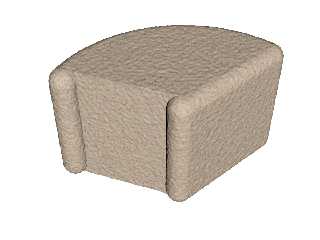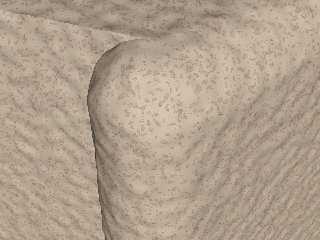 |
 |
|
 |
|
 |
|  |
|  |
|
 |
|
 |
|  |
|  |
|
 |
I can make a sphere where i want;
sqrt(
pow(x-Inside_length,2)
+pow(y-Height+Edge,2)
+pow(z-Edge,2)
)-Block_Round_corner,//sphere outside top
I can rotate the sphere;
//x=x*cos(radians(Angle)) - z*sin(radians(Angle))
//z=x*sin(radians(Angle)) + z*cos(radians(Angle))
//Inside_length=Inside_length*cos(radians(Angle)) - Edge*sin(radians(Angle))
//Edge=Inside_length*sin(radians(Angle)) + Edge*cos(radians(Angle))
sqrt(
pow(x-(Inside_length*cos(radians(-Angle)) - Edge*sin(radians(-Angle))),2)
+pow(y-Height+Edge,2)
+pow(z+(Inside_length*sin(radians(-Angle)) + Edge*cos(radians(-Angle))),2)
)-Block_Round_corner,//sphere outside top
I can make a cylinder;
max(//reference edge good
sqrt(pow(x-Inside_length,2)+pow(z-Edge,2))-Block_Round_corner,
y-Height+Edge,
-y+Edge
)
I can rotate this cylinder, but only on its infinite axis;
max(//rotated edge good
sqrt(
pow(x-Inside_length*cos(radians(Angle)) - Edge*sin(radians(Angle)),2)
+pow(z-Inside_length*sin(radians(Angle)) + Edge*cos(radians(Angle)),2)
)-Block_Round_corner,
y-Height+Edge,
-y+Edge
)
Now my question;
How do I rotate around y axis
max(//reference edge good
sqrt(pow(y-Edge,2)+pow(z-Edge,2))-Block_Round_corner,
x-Inside_length,
-x+Inside_corner
)
I can substitute my z, but what do I use for my x?
After trying some other stuff, I also have;
sqrt(
pow(y-Edge,2)
+pow(z-Edge,2)
+pow(x-select(min(x-Inside_length,0),max(x,Inside_corner),min(x,Inside_length)),2)
)-Block_Round_corner
Witch seems to give a cylinder with rounded ends.
I can't seem to rotate this ether.
Suggestions, hints?
First image: my work so far on an isosurface rounded_cylinder_section.
Second image: my cylinder with rounded ends equation.
Stephen S
Post a reply to this message
Attachments:
Download 'stone_blocks_0000.png' (769 KB)
Download 'stone_blocks_0002.png' (267 KB)
Preview of image 'stone_blocks_0000.png'

Preview of image 'stone_blocks_0002.png'

|
 |
|  |
|  |
|
 |
|
 |
|  |
|  |
|
 |
...
> First image: my work so far on an isosurface rounded_cylinder_section.
...
I will probably switch to
f_rounded_box(x,y,z, P0, P1, P2, P3)
from functions.inc.
I can rotate and place this, but I would still like to know how to do it
with a cylinder.
My use of min()/max() in the isosurface causes some artifacts at close
inspection.
Comments welcome;
Stephen S
Post a reply to this message
Attachments:
Download 'stone_blocks_0001.png' (1389 KB)
Preview of image 'stone_blocks_0001.png'

|
 |
|  |
|  |
|
 |
|
 |
|  |
|  |
|
 |
> After trying some other stuff, I also have;
> sqrt(
> pow(y-Edge,2)
> +pow(z-Edge,2)
>
> +pow(x-select(min(x-Inside_length,0),max(x,Inside_corner),min(x,Inside_length)),2)
>
> )-Block_Round_corner
>
> Witch seems to give a cylinder with rounded ends.
> I can't seem to rotate this ether.
>
> Suggestions, hints?
To rotate the shape by (eg) 30 degrees about the z axis, you need to
replace x,y & z in your function with x,y,z rotated by -30 degrees about
the z axis.
For rotation about z, you need:
( from https://en.wikipedia.org/wiki/Rotation_matrix#Basic_rotations )
x' = x*cos(a) - y*sin(a)
y' = x*sin(a) + y*cos(a)
z' = z
Putting those into your function above you get something like:
#local a = radians(30);
sqrt(
pow((x*sin(a)+y*cos(a))-Edge,2)
+pow(z-Edge,2)
+pow((x*cos(a)-y*sin(a))-select(min((x*cos(a)-y*sin(a))-Inside_length,0),max((x*cos(a)-y*sin(a)),Inside_corner),min((x*cos(a)-y*sin(a)),Inside_length)),2)
)-Block_Round_corner
Post a reply to this message
|
 |
|  |
|  |
|
 |
|
 |
|  |
|  |
|
 |
On 10/11/2016 09:25 PM, StephenS wrote:
...
>
> Now my question;
> How do I rotate around y axis
> max(//reference edge good
> sqrt(pow(y-Edge,2)+pow(z-Edge,2))-Block_Round_corner,
> x-Inside_length,
> -x+Inside_corner
> )
> I can substitute my z, but what do I use for my x?
>
>
> After trying some other stuff, I also have;
> sqrt(
> pow(y-Edge,2)
> +pow(z-Edge,2)
>
> +pow(x-select(min(x-Inside_length,0),max(x,Inside_corner),min(x,Inside_length)),2)
>
> )-Block_Round_corner
>
> Witch seems to give a cylinder with rounded ends.
> I can't seem to rotate this ether.
>
> Suggestions, hints?
>
> First image: my work so far on an isosurface rounded_cylinder_section.
> Second image: my cylinder with rounded ends equation.
>
> Stephen S
>
See too:
http://wiki.povray.org/content/Documentation:Tutorial_Section_3.2#Transformations_on_functions
Bill P.
Post a reply to this message
|
 |
|  |
|  |
|
 |
|
 |
|  |
|  |
|
 |
On 10/11/2016 09:35 PM, StephenS wrote:
> ...
>> First image: my work so far on an isosurface rounded_cylinder_section.
> ...
> I will probably switch to
> f_rounded_box(x,y,z, P0, P1, P2, P3)
> from functions.inc.
> I can rotate and place this, but I would still like to know how to do it
> with a cylinder.
>
> My use of min()/max() in the isosurface causes some artifacts at close
> inspection.
>
> Comments welcome;
>
> Stephen S
>
With min, max I think these sorts of artifacts are always more or less
there at the threshold-seam between functions. They might or might not
be seen due AA, application or not of noise/displacement to the
component functions into max/min, ray direction, etc.
Increasing accuracy (smaller value) in your isosurface sometimes helps.
Using a blobbing function instead of - or in addition to min/max - will
fix the issue in my experience at the expense of the blobbing.
Bill P.
Post a reply to this message
|
 |
|  |
|  |
|
 |
|
 |
|  |
|  |
|
 |
On 12/10/2016 4:03 AM, William F Pokorny wrote:
...
> With min, max I think these sorts of artifacts are always more or less
> there at the threshold-seam between functions.
...
The rounding is meant to be small, to allow the larger block to stand
out. It's unlikely to be seen at the scale I intend.
Thanks.
Stephen S
Post a reply to this message
|
 |
|  |
|  |
|
 |
|
 |
|  |
|  |
|
 |
On 12/10/2016 3:10 AM, scott wrote:
...
> For rotation about z, you need:
>
> ( from https://en.wikipedia.org/wiki/Rotation_matrix#Basic_rotations )
>
> x' = x*cos(a) - y*sin(a)
> y' = x*sin(a) + y*cos(a)
> z' = z
>
> Putting those into your function above you get something like:
>
> #local a = radians(30);
>
> sqrt(
> pow((x*sin(a)+y*cos(a))-Edge,2)
> +pow(z-Edge,2)
>
>
>
+pow((x*cos(a)-y*sin(a))-select(min((x*cos(a)-y*sin(a))-Inside_length,0),max((x*cos(a)-y*sin(a)),Inside_corner),min((x*cos(a)-y*sin(a)),Inside_length)),2)
>
> )-Block_Round_corner
>
sqrt(
pow(y-Edge,2)
+pow(x*sin(radians(-Angle)) + z*cos(radians(-Angle))+Edge,2)
+pow(x*cos(radians(-Angle)) -
z*sin(radians(-Angle))-select(min(x*cos(radians(-Angle)) -
z*sin(radians(-Angle))-Inside_length,0),max(x*cos(radians(-Angle)) -
z*sin(radians(-Angle)),Inside_corner),min(x*cos(radians(-Angle)) -
z*sin(radians(-Angle)),Inside_length)),2)
)-Block_Round_corner,
I though I tried something like this before I posted.
This works. Thanks.
Changes I made:
Angle refers to the final shape, and -Angle is how I get it.
For the z. I changed to +Edge, to line up with the final shape.
Comments welcome;
Stephen S
Post a reply to this message
Attachments:
Download 'stone_blocks_0000.png' (215 KB)
Preview of image 'stone_blocks_0000.png'

|
 |
|  |
|  |
|
 |
|
 |
|  |
|  |
|
 |
Does this help any?
https://en.wikipedia.org/wiki/Rotation_of_axes
Post a reply to this message
|
 |
|  |
|  |
|
 |
|
 |
|  |
|  |
|
 |
On 12/10/2016 10:16 AM, Bald Eagle wrote:
> Does this help any?
>
> https://en.wikipedia.org/wiki/Rotation_of_axes
Not so much.
I use the one from the POV-Ray docs, Isosurface tutorial.
However I quickly lose track with all but the simplest equations.
Stephen S
Post a reply to this message
|
 |
|  |
|  |
|
 |
|
 |
|  |
|
 |




![]()